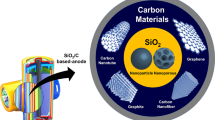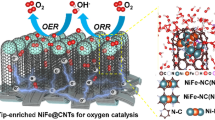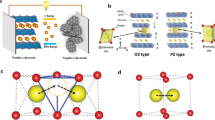Abstract
Tricobalt tetroxide (Co3O4) is one of the promising anodes for lithium-ion batteries (LIBs) due to its high theoretical capacity. However, the poor electrical conductivity and the rapid capacity decay hamper its practical application. In this work, we design and fabricate a hierarchical Co3O4 nanorods/N-doped graphene (Co3O4/NG) material by a facile hydrothermal method. The nitrogen-doped graphene layers could buffer the volume change of Co3O4 nanorods during the delithium/lithium process, increase the electrical conductivity, and profit the diffusion of ions. As an anode, the Co3O4/NG material reveals high specific capacities of 1873.8 mA·h·g−1 after 120 cycles at 0.1 A·g−1 as well as 1299.5 mA·h·g−1 after 400 cycles at 0.5 A·g−1. Such superior electrochemical performances indicate that this work may provide an effective method for the design and synthesis of other metal oxide/N-doped graphene electrode materials.
Similar content being viewed by others
References
Wang Z, Chen L, Feng J, et al. In-situ grown SnO2 nanospheres on reduced GO nanosheets as advanced anodes for lithium-ion batteries. ChemistryOpen, 2019, 8(6): 712–718
Liu M, Deng X, Ma Y, et al. Well-designed hierarchical Co3O4 architecture as a long-life and ultrahigh rate capacity anode for advanced lithium-ion batteries. Advanced Materials Interfaces, 2017, 4(19): 1700553
Chen F, Chen Z, Dai Z, et al. Self-templating synthesis of carbon-encapsulated SnO2 hollow spheres: A promising anode material for lithium-ion batteries. Journal of Alloys and Compounds, 2020, 816: 152495
Chen Z, Wang S, Zhang Z, et al. Facile synthesis of Co3O4/Co@N-doped carbon nanotubes as anode with improved cycling stability for Li-ion batteries. Electrochimica Acta, 2018, 292: 575–585
Liang C, Cheng D, Ding S, et al. The structure dependent electrochemical performance of porous Co3O4 nanoplates as anode materials for lithium-ion batteries. Journal of Power Sources, 2014, 251: 351–356
Li H, Li Z, Wu X, et al. Shale-like Co3O4 for high performance lithium/sodium ion batteries. Journal of Materials Chemistry A: Materials for Energy and Sustainability, 2016, 4(21): 8242–8248
Zhang Z, Fu Y, Yang X, et al. Hierarchical MoSe2 nanosheets/reduced graphene oxide composites as anodes for lithium-ion and sodium-ion batteries with enhanced electrochemical performance. ChemNanoMat, 2015, 1(6): 409–114
Wang Y, Zhang X, Wen G. Dual carbon protected SnO2 with superior lithium storage performance. Applied Surface Science, 2020, 531: 147331
Geng C, Yu J, Shi F. Few-layers of graphene modified TiO2/graphene composites with excellent electrochemical properties for lithium-ion battery. Ionics, 2019, 25(7): 3059–3068
Zhang Y, Zhang K, Ren S, et al. 3D nanoflower-like composite anode of α-Fe2O3/coal-based graphene for lithium-ion batteries. Journal of Alloys and Compounds, 2019, 792: 828–834
Qiu W, Xiao H, Li Y, et al. Nitrogen and phosphorus codoped vertical graphene/carbon cloth as a binder-free anode for flexible advanced potassium ion full batteries. Small, 2019, 15(23): 1901285
Hong Y, Mao W, Hu Q, et al. Nitrogen-doped carbon coated SnO2 nanoparticles embedded in a hierarchical porous carbon framework for high-performance lithium-ion battery anodes. Journal of Power Sources, 2019, 428: 44–52
Vilian A T E, Dinesh B, Rethinasabapathy M, et al. Hexagonal Co3O4 anchored reduced graphene oxide sheets for highperformance supercapacitors and non-enzymatic glucose sensing. Journal of Materials Chemistry A: Materials for Energy and Sustainability, 2018, 6(29): 14367–14379
Ying H, Zhang S, Meng Z, et al. Ultrasmall Sn nanodots embedded inside N-doped carbon microcages as high-performance lithium and sodium ion battery anodes. Journal of Materials Chemistry A: Materials for Energy and Sustainability, 2017, 5(18): 8334–8342
Youn D H, Patterson N A, Park H, et al. Facile synthesis of Ge/N-doped carbon spheres with varying nitrogen content for lithium ion battery anodes. ACS Applied Materials & Interfaces, 2016, 8(41): 27788–27794
Ni W, Cheng J, Shi L, et al. Integration of Sn/C yolk-shell nanostructures into free-standing conductive networks as hierarchical composite 3D electrodes and the Li-ion insertion/extraction properties in a gel-type lithium-ion battery thereof. Journal of Materials Chemistry A: Materials for Energy and Sustainability, 2014, 2(45): 19122–19130
Huang S, Wang M, Jia P, et al. N-graphene motivated SnO2@SnS2 heterostructure quantum dots for high performance lithium/sodium storage. Energy Storage Materials, 2019, 20: 225–233
Zeng H, Xing B, Chen L, et al. Nitrogen-doped porous Co3O4/graphene nanocomposite for advanced lithium-ion batteries. Nanomaterials, 2019, 9(9): 1253
Zhang J, Li F, Chen W, et al. Facile synthesis of hollow Co3O4-embedded carbon/reduced graphene oxides nanocomposites for use as efficient electrocatalysts in oxygen evolution reaction. Electrochimica Acta, 2019, 300: 123–130
Zhao Y, Liu C, Yi R, et al. Facile preparation of Co3O4 nanoparticles incorporating with highly conductive MXene nanosheets as high-performance anodes for lithium-ion batteries. Electrochimica Acta, 2020, 345: 136203
Zhao X, Xu H, Hui Z, et al. Electrostatically assembling 2D nanosheets of MXene and MOF-derivatives into 3D hollow frameworks for enhanced lithium storage. Small, 2019, 15(47): 1904255
Feng K, Park H W, Wang X, et al. High performance porous anode based on template-free synthesis of Co3O4 nanowires for lithium-ion batteries. Electrochimica Acta, 2014, 139: 145–151
Yan C, Chen G, Zhou X, et al. Template-based engineering of carbon-doped Co3O4 hollow nanofibers as anode materials for lithium-ion batteries. Advanced Functional Materials, 2016, 26(9): 1428–1436
Wang S, Wang R, Chang J, et al. Self-supporting Co3O4/graphene hybrid films as binder-free anode materials for lithium ion batteries. Scientific Reports, 2018, 8(1): 3182
Jing M, Zhou M, Li G, et al. Graphene-embedded Co3O4 rose-spheres for enhanced performance in lithium ion batteries. ACS Applied Materials & Interfaces, 2017, 9(11): 9662–9668
Wu M, Chen H, Lv L, et al. Graphene quantum dots modification of yolk-shell Co3O4@CuO microspheres for boosted lithium storage performance. Chemical Engineering Journal, 2019, 373: 985–994
Wu D, Wang C, Wu H, et al. Synthesis of hollow Co3O4 nanocrystals in situ anchored on holey graphene for high rate lithium-ion batteries. Carbon, 2020, 163: 137–144
Liu Y, Wan H, Zhang H, et al. Engineering surface structure and defect chemistry of nanoscale cubic Co3O4 crystallites for enhanced lithium and sodium storage. ACS Applied Nano Materials, 2020, 3(4): 3892–3903
Wang C, Wang F, Zhang L, et al. Multi-dimensionally hierarchical self-supported Cu@Cu2 + 1O@Co3O4 heterostructure enabling superior lithium-ion storage and electrocatalytic oxygen evolution. Chemical Engineering Journal, 2021, 405: 126699
Huang Y, Fang Y, Lu X F, et al. Co3O4 hollow nanoparticles embedded in mesoporous walls of carbon nanoboxes for efficient lithium storage. Angewandte Chemie International Edition, 2020, 59(45): 19914–19918
Choi B G, Chang S J, Lee Y B, et al. 3D heterostructured architectures of Co3O4 nanoparticles deposited on porous graphene surfaces for high performance of lithium ion batteries. Nanoscale, 2012, 4(19): 5924–5930
Chen H, Jia B E, Lu X, et al. Two-dimensional SnSe2/CNTs hybrid nanostructures as anode materials for high-performance lithium-ion batteries. Chemistry, 2019, 25(42): 9973–9983
Chen X, Lv L, Sun W, et al. Ultrasmall MoC nanoparticles embedded in 3D frameworks of nitrogen-doped porous carbon as anode materials for efficient lithium storage with pseudocapacitance. Journal of Materials Chemistry A: Materials for Energy and Sustainability, 2018, 6(28): 13705–13716
Hou B H, Wang Y Y, Ning Q L, et al. Self-supporting, flexible, additive-free, and scalable hard carbon paper self-interwoven by 1D microbelts: Superb room/low-temperature sodium storage and working mechanism. Advanced Materials, 2019, 31(40): 1903125
Xie J, Li X, Lai H, et al. A robust solid electrolyte interphase layer augments the ion storage capacity of bimetallic-sulfide-containing potassium-ion batteries. Angewandte Chemie International Edition, 2019, 58(41): 14740–14747
Cook J B, Kim H-S, Lin T C, et al. Pseudocapacitive charge storage in thick composite MoS2 nanocrystal-based electrodes. Advanced Energy Materials, 2017, 7(2): 1601283
Acknowledgements
This project was supported by the China Postdoctoral Science Foundation (Grant Nos. 2019M662405 and 2019M650612), the Natural Science Foundation of Shandong Province (ZR2019BF047 and ZR2020KE059), and the School City Integration in Zibo (2019ZBXC299).
Author information
Authors and Affiliations
Corresponding authors
Rights and permissions
About this article
Cite this article
Wang, Y., Zhang, X., Meng, F. et al. Stabilizing Co3O4 nanorods/N-doped graphene as advanced anode for lithium-ion batteries. Front. Mater. Sci. 15, 216–226 (2021). https://doi.org/10.1007/s11706-021-0552-x
Received:
Accepted:
Published:
Issue Date:
DOI: https://doi.org/10.1007/s11706-021-0552-x




